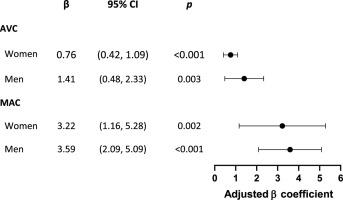Atherosclerosis ( IF 5.3 ) Pub Date : 2021-08-26 , DOI: 10.1016/j.atherosclerosis.2021.08.031 Daniele Massera 1 , Petra Buzkova 2 , Anna E Bortnick 3 , David S Owens 4 , SongShou Mao 5 , Dong Li 6 , Ian H De Boer 7 , Bryan R Kestenbaum 7 , Matthew J Budoff 5 , Jorge R Kizer 8

|
Background and aims
Bone and mineral metabolism has been implicated in the pathophysiology of cardiac valve calcification. Whether bone demineralization, a common aging-related disorder, promotes calcific valve disease remains uncertain. We tested the hypothesis that low bone mineral density (BMD) is associated with greater incidence/progression of cardiac valve calcification in the Multi-Ethnic Study of Atherosclerosis.
Methods
Using linear mixed-effects models, we related baseline measurement of BMD of the thoracic vertebrae by computed tomography (CT) in 6768 participants to serial CT assessments of aortic valve calcification (AVC) and mitral annular calcification (MAC) obtained over a >10-year period.
Results
After multivariable adjustment, lower BMD (per SD decrement) was associated with accelerated increase in AVC over time in women (0.76 [95% CI 0.42,1.09] Agatston Units [AU]/year) and men (1.41 [95% CI 0.48,2.33] AU/year), as well as for MAC in women (3.22 [95% CI 1.16,5.28] AU/year) and men (3.59 [95% CI 2.09,5.09] AU/year). Significant effect modification was observed, with more pronounced BMD-related acceleration of AVC and MAC progression in older or white participants of one or both sexes, as well as by estimated glomerular filtration rate, though the latter differed by sex for AVC and MAC.
Conclusions
In this multi-ethnic cohort, low thoracic BMD was significantly, but modestly, associated with increased AVC and MAC progression. This suggests that altered bone mineral metabolism does not have a major impact on calcific valve disease in the general population, but the possibility of a more meaningful influence in higher-risk individuals with osteoporosis will require further investigation.
中文翻译:

骨矿物质密度和主动脉瓣和二尖瓣环钙化的长期进展:动脉粥样硬化的多种族研究
背景和目标
骨和矿物质代谢与心脏瓣膜钙化的病理生理学有关。骨脱矿是一种常见的与衰老相关的疾病,是否会促进钙化性瓣膜病仍不确定。我们在动脉粥样硬化的多种族研究中检验了低骨矿物质密度 (BMD) 与心脏瓣膜钙化的发生率/进展增加相关的假设。
方法
使用线性混合效应模型,我们将通过计算机断层扫描 (CT) 对 6768 名参与者进行的胸椎 BMD 基线测量与主动脉瓣钙化 (AVC) 和二尖瓣环钙化 (MAC) 的连续 CT 评估联系起来,该评估超过 10年期间。
结果
多变量调整后,女性(0.76 [95% CI 0.42,1.09] Agatston 单位 [AU]/年)和男性(1.41 [95% CI 0.48, 2.33] AU/年),以及女性(3.22 [95% CI 1.16,5.28] AU/年)和男性(3.59 [95% CI 2.09,5.09] AU/年)的 MAC。观察到显着的效果改变,在一种或两种性别的老年或白人参与者中,AVC 和 MAC 进展的 BMD 相关加速更明显,以及估计的肾小球滤过率,尽管后者因 AVC 和 MAC 的性别而异。
结论
在这个多种族队列中,低胸部 BMD 与 AVC 和 MAC 进展增加显着但适度相关。这表明改变的骨矿物质代谢对一般人群的钙化性瓣膜病没有重大影响,但对高危骨质疏松症患者产生更有意义影响的可能性需要进一步研究。



























 京公网安备 11010802027423号
京公网安备 11010802027423号